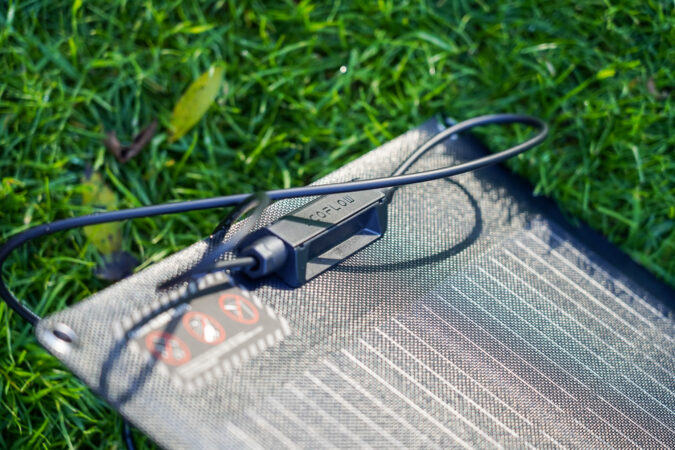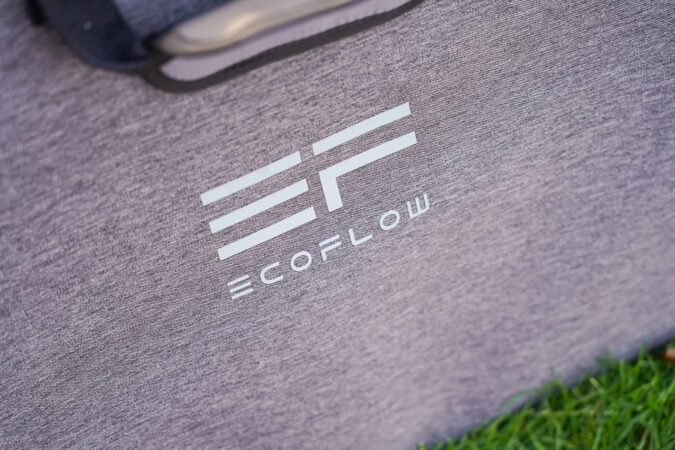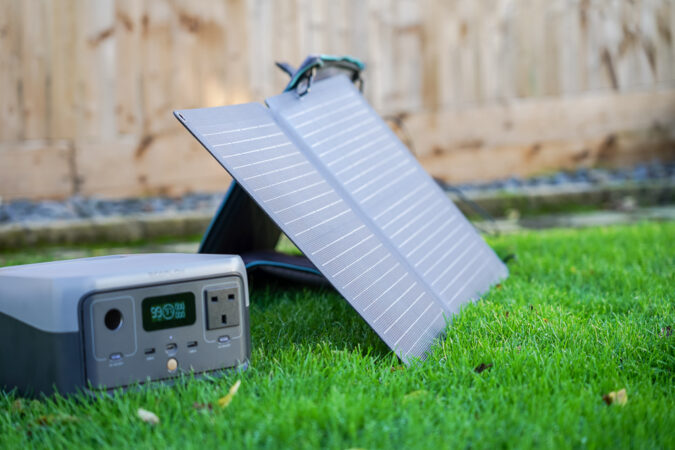A portable power station is a must-have for anyone going camping, enjoying that #vanlife experience, or just wanting to stay detached from the grid. However, there’s one key flaw with every power station… What happens when it, eventually, runs out of juice? Do you have to just drive down to a nearby town and beg the locals to use the mains? Or, ideally, you can have it plugged into a solar panel, instead.
As we’re tinkering around with our own campervan, we’ve gradually become more aware of just how important these considerations are. We’ve had power stations before, but not much in the way when it comes to charging it while we’re on the move. At least, until we were acquainted with EcoFlow and its portable solar panels. How it works is pretty self-explanatory – it’s a solar panel that folds up.
You carry it about in a bag, and when you need to or see sunlight, you fold it out, lay it on the ground, and plug it into your EcoFlow power station. In our case, we’ve previously used it alongside EcoFlow’s RIVER 2. If you’re not familiar with this sort of item before, you can think of it as a huge battery bank. It was great, and the addition of solar panels now allows us to charge the unit itself from wherever.
As long as, once again, you have exposure to sunlight. There are plenty of scenarios where this might come in handy. For example, if you’re out camping for a whole weekend, and are concerned that you would run out of power in the middle of it. Or, perhaps you might use your power station as a backup power source in the event of a winter storm, or if the electrical grid near you is prone to blackouts.
Continuous Power (With Help From The Sun)
This EcoFlow 110 solar panel here is designed to work with EcoFlow’s range of power stations. In this instance, we tried it out to have it continuously top-up an EcoFlow RIVER 2. Nonetheless, it works just as well with its siblings. That includes the old RIVER, the larger DELTA mini, and the even bigger DELTA 2. The inclusion of a portable solar panel ensures that you’re less likely to completely run out of power.
Speaking of, the charging rate from the solar panels is pretty good. Given the (comparatively) smaller RIVER 2’s battery capacity of 256Wh, it would take you around 2.5 hours or so of exposure to sunlight to charge it up fully using the solar panel’s 110W output. All you need to do is unfold the solar panel’s four sides, and have it pointed toward direct sunlight. The latter is vital, as you need good UV.
As such, when you’re deploying those solar panels, you need to be very cognizant of how you position them to face the sun. Even a bit of cloud cover can reduce the charge rate to a noticeable extent. You have to, ideally, have it pointed so that sunlight is beaming off of it. In other words, it’s a bit of a challenge to actually get near the full 110W of charging output, though you can still get close enough.
In our experience, the best that we managed to get from our time with it was around 90W. EcoFlow’s own website touts a 22% to 23% conversion rate, on top of a plus-minus 5W margin with its charging output. These figures are certainly better than a lot of other portable solar panels out there. However, besides being able to just charge up our power station, is it too much of a hassle to use?
All You Need Is Plug And Play
While a solar panel kit like this may seem like more of an afterthought in your off-the-grid equipment list, it’s good to see that EcoFlow’s put a lot of thought into it, regardless. As far as its design goes, it’s well-built and sturdy, with a robust construction best suited to tackle the elements. In particular, the solar panel’s outer shell has an IP68 certification for both waterproofing and dust-proofing.
It’s also pleasing to look at, if aesthetics are worth anything. Plus, it’s rather compact, allowing you to fold it back up like a pamphlet for safekeeping once you’re done using it. Although, it’s worth being a bit wary if you’re thinking of going backpacking with this. Mobile solar panels like the EcoFlow there is often a lot heavier and beefier than it physically looks in person, and it’s not even the biggest.
But… More on that later. Elsewhere, usability is another strong point. It’s a plug-and-play connection with EcoFlow’s mobile power stations (like that aforementioned RIVER 2), and charges automatically once you have it plugged in. The carrying bag that it comes with further doubles as a stand. You can thus use it to prop up the solar panels and angle it just about right in relation to the sunlight.
Granted, depending on your needs, you can otherwise have the solar panels lying flat on the ground. Or, have it hung up on a wall, mounted onto the roof of your caravan, and anywhere in between. As you’re out and about, foldable solar panels like it are quite some handy accessories that manage to stamp out any battery capacity anxieties, while also being easy to use and sitting neatly out of the way.
Easier To Use, And Endlessly Practical
You could use something like this to gradually charge up your power station during the day, making sure that you can last out the night and keep going for days on end. Hence, further reducing dependency on needing to find the nearest mains outlet when you’re out camping in the middle of nowhere. The only caveat, once again, is that you have at least a decent amount of sunlight where you’re going.
With that functionality alone, solar power has become a permanent fixture and addition to our campervan project. Should 110W of charging not suffice, you can instead opt for EcoFlow’s beefier solar panels. The larger portable ones come with 160W, 220W, and a whopping 400W of charging. EcoFlow also has a rigid ( this one can’t be folded) solar panel for a respectable 100W of charging output.
Additionally, a folding (you can slightly bend and twist it) solar panel, which features 100W of charging, as well. But going back to this 110W foldable solar panel here, does this justify the expense? Retail, it’s priced at £319, but it’s currently marked down to £289 at the time of writing, thanks to an ongoing year-end, Christmas sale. It’s not a cheap bit of kit, that’s for sure.
But for what it does… And does it so well, in practice… Given how easy it was to set up and get going, the convenience factor and peace of mind alone are worth it. Furthermore, acting as a continual power supply for your power station – again, as long as you have good sunlight. While one may say that this isn’t an absolutely necessary item to get, it’s certainly going to make your life on the go a lot easier.













